It was high tide when we got up, and we were surprised to see that one of the fenders set high specifically for high tide had popped out and our rub rail was bumping up against the dock. Oh, what we would give for a floating dock right now. The things we used to take for granted”¦ It was yet another day of heavy wind and cold, though not as bitterly cold as yesterday. We decided to brave the cold and go sightseeing.
Our original plan was to take the cable car to the top of the rock and walk down, stopping at the various attractions and monuments along the way. Even though the cable car was running, we were a little leery about it in the heavy wind, so we opted for a taxi tour instead. In retrospect, this was a good choice. We hadn’t realized how far apart the sights are from one another. It would have been an awful lot of walking the other way. And the taxi driver acted as a tour guide, giving us all kinds of interesting information about Gibraltar, which we always enjoy.
We piled into a minivan with two other couples and we headed up a sharply sloped road. The upper portion of the rock is a nature preserve, the only place in Europe that has wild primates. The southern entrance gate is at a pretty viewpoint where you can see the Med, the Atlantic, Strait of Gibraltar, and North Africa. The driver stopped so we could all get out and take photos.
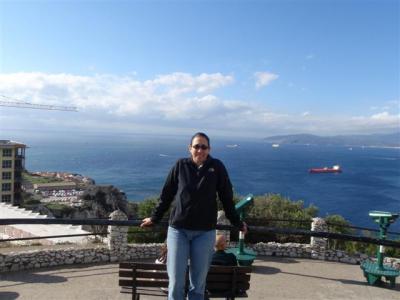
We continued up the rock to the next stop, St. Michael’s cave, a natural cave 300 meters above sea level. Neolithic artifacts dating back 40,000 years ago have been found in the cave. The cave is referred to in ancient texts, some believing it to be bottomless, others believing it to be an undersea passage to Africa. The Greeks believed this cave to be the Gates of Hades, the entrance to the underworld. During WWII, the cave was prepared for use as an emergency hospital, but never actually used in that capacity. Since it has great acoustics, it was later converted into an auditorium and is still used as such.
There were the most adorable little monkeys outside the entrance to greet us. They are probably the cutest wild monkeys we have seen yet. We walked in through the “back door”, a man made tunnel that leads into the cave. The tunnel was added for more ventilation when it was turned into a hospital, and in the process stumbled upon another deeper system of caves with a lake. You have to make special arrangements to take a tour down there, so we won’t see it today.
The auditorium is the same size as a typical elementary school auditorium. There were very few stalagmite and stalactite formations, and we suspect they once existed and were removed. The floor had been leveled and graded for the seating and stage area. We know it is a cool setting for a theater, but it is kind of sad to see such an amazing creation of Mother Nature tampered with.
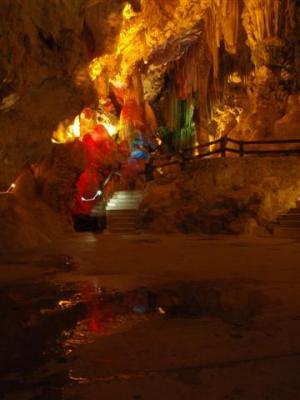
The back drop behind the small stage is stalactites and stalagmites. Once you get on the stage, you realize you can wander about between the limestone pillars. And once you start weaving your way through them, you get a sense of how big the cave really is. The auditorium is only a segment of the total cave size and it is actually much larger. There is a set of stairs that take you down to a small lower level. Back here the natural formations are numerous and impressive. Overall, it is similar to most other caves, except there are more “columns” made by stalagmites and stalactites joining in the middle than most, and the columns are noticeably thicker than the average. There are two small exhibit areas tucked away in small “nooks” of formations. One is signs about the history of the cave. The other is where a large stalagmite broke and fell hundreds of years ago, and time adhered it to the floor. They cut a cross section from it and put it on display. It is 4’6″ wide (1.35m). They grow kind of like trees, getting bigger each and every year, except not in perfect rings like trees do. The light brown patches are growth during rainy years, the dark brown patches growth in drier years. We’ve never seen anything like it before and found it to be interesting.
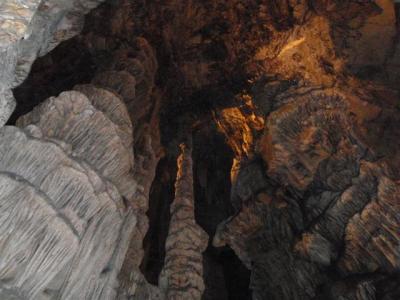

From the cave, we piled back in the car and headed up to the highest point you can get to by car. There was a walking trail to the peak, but we didn’t hike up there. It was too cold and windy. At this particular spot food is left out for the monkeys, so you can imagine there are a plethora of monkeys around. We watched them eat. While we were standing there, the monkeys jumped on us! Both of us had a monkey spontaneously climb up on us. At first we were afraid. After all, the monkeys were saw in Asia were mean and bite. But our guide assured us that it was OK. He said the monkeys wig out if you touch them, but they like to touch people and they will happily climb all over you as long as you don’t touch them. There are also a lot of birds flying around up here. It’s fun to watch them, too. The first photo is of the peak, and if you look to the right you can see monkeys on the road. The last photo is the view of the Bay of Gibraltar. Spain is in the background and in the foreground are the commercial docks and new waterfront developments. The ships in the bay are anchored.
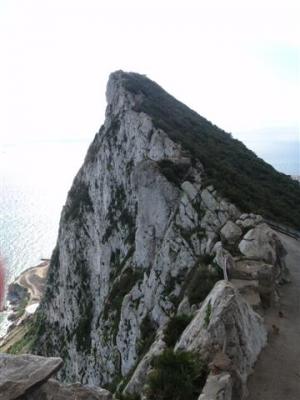

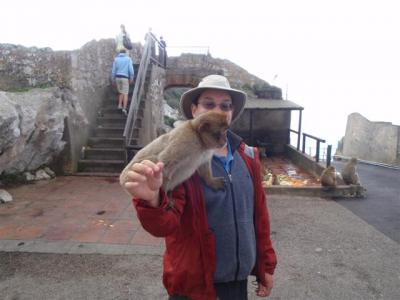

The final stop on the tour were the Great Siege Tunnels, a man made tunnel on the north side of the rock carved by the British Army during the Great Siege of 1779 1783. To get there, the car took a road almost down to the bottom of the preserve, then back up to get to the north side. As a side note, this road was clearly not made for cars. It is wide enough for a car, but the switchback turns are so sharp that the driver slows almost to a complete stop at the turns. We can see someone unfamiliar with the roads having a nasty accident. The rock along the side of the roads have thick metal rings inset into them every few dozen feet. These rings were used to transport canons up the rock. They would attach a rope to the cannons and put the rope though the rings for extra leverage. They would slowly drag those monstrously heavy things up ring by ring. And there are a lot of cannons mounted all over the rock, and we’re sure there were probably more back in the day.
It is basically a tunnel paralleling downward along the face of the rock with small rooms dug out along the sides of the tunnel. It is actually a lot longer than you would expect, and we didn’t get to see it all. Some of it is closed for renovation. Apparently, one of the rooms we didn’t see is big enough to hold a banquet in. Along the face there is series of “windows”, basically open holes in the rock, with a canon sticking out of each one. The first opening was made for ventilation purposes, but when they figured out it was a good place to mount a cannon, they opened lots of holes. As a result, it was drafty and cold in the tunnels. These tunnels are just a tiny fragment of the tunnel system in Gibraltar, the vast majority of which are not open to the public. The second photo is the view from the windows. Gibraltar is in the foreground (note the shadow of the rock), the air strip in the middle, Spain in the background. The left is the Bay of Gibraltar, the right is the east coast of the peninsula on the Mediterranean.
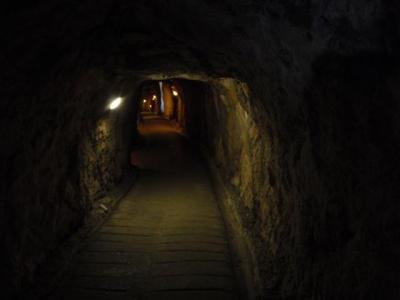

Most of the rooms were empty. According to the signs, they were all used for different purposes, many of them storage of specific goods. A couple rooms had displays. One display was of guard and there was a motion sensor on it, so as you approached, the wax guard screamed “Who goes there!” Another one showed soldiers loading canons. Another room showed old fashioned generators that were installed and maintained during WWII. There was a flight of stairs, closed to the public that led down to the living quarters of the engineers who ran the generators.
There were signs posted throughout with bits of history and interesting information about the tunnels. One that was shocking was the weekly rations soldiers were given. They got bread, pork, salt fish, peas, flour, raisins, rice, butter and oatmeal, in quantities so small it would only feed you for two days, not a week.
To be continued”¦

Monkey on your back? You can get help for that sort of thing!!!!
Sorry couldn’t resist!
Wishing you fair winds and following seas on your Atlantic crossing.
tb